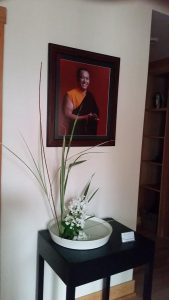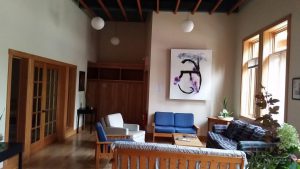Saturday
Pacific NorthwestA Center That Works
A concise description of the outer, inner and secret levels of Shambhala Center design
by Russell Rodgers
 Recently, the Kootenay Shambhala Centre in Nelson, British Columbia, purchased a building. Because we had to acquire the services of a non-sangha architect for the renovations, it seemed like a good idea to summarize for them in plain language some of the basic elements of how a Shambhala Centre functions and how it is designed. This summary is offered here as something that may be useful to other centers working with architects and designers who are not necessarily Shambhala practitioners.
Recently, the Kootenay Shambhala Centre in Nelson, British Columbia, purchased a building. Because we had to acquire the services of a non-sangha architect for the renovations, it seemed like a good idea to summarize for them in plain language some of the basic elements of how a Shambhala Centre functions and how it is designed. This summary is offered here as something that may be useful to other centers working with architects and designers who are not necessarily Shambhala practitioners.
In Shambhala design, one has three levels of manifestation. Ideally, these are reflected in the spatial organization of the building. For a more complete description, see Shambhala Environments. To put it briefly, here are some main points:
1. There is an outer level that is reflected in what one can perceive directly with the senses. Anyone can see this: so these parts of the building are the most public, the most obvious, and the most universally accessible. The entry, community room, children’s room and kitchen operate on this level.
2. There is an inner level that reflects energy and felt atmosphere. This level is felt individually by each person, and it’s meaning has to be personally experienced. What an individual feels is not obvious to others, because it is an inner experience. This level is what is being worked on in the main shrine room. People might feel a sense of spaciousness and presence in the room, but they would mostly be concerned with thoughts and perceptions that occur within that spaciousness. Spatially, it would be near the community room, but need to be somewhat protected from its sound and activity.
3. There is a secret level that reflects ultimate understanding. Like the inner level, it is not obvious to others – but here it is even less obvious. It refers to the most basic level of mind, the spacious emptiness that cannot be described with words, but which has the power and potential to manifest as thoughts, emotions and perceptions. Here we are dealing with the spacious mind itself, beyond the obvious individual occurrences. Access to this level is transmitted by realized persons in the lineage. Subsequent to that transmission, the vajrayana practices bring the practitioner towards fruition. The Sakyong’s room and the vajrayana shrine room would be in parts of the building that are the least accessible, reflecting the fact that it would be a mistake to try to interpret this level with conventional words and thinking. At the same time, it reflects the ultimate importance of the secret mandala.
All the different levels, within and without the building, should reflect a sense of dignity, wakefulness, uplift and spaciousness. However, as one gets closer to the secret level, the décor reflects this more and more and takes on a transmission quality.
For example, one could experience an ikebana arrangement according to outer, inner and secret levels. On the outer level, anyone can see the flowers. On the next level, there is the spaciousness, energy and beauty of the arrangement. Each person experiences this in private on an inner level. On a secret level, there is the spacious and powerful nature of the mind itself. This level is the ultimate nature of the images and the mind that manifests them.
It’s not that the public is cut off from the inner and secret parts of the building, but there’s a sense that preparation is required both to experience it properly and to understand what one has experienced. If these areas are not somewhat protected, their meaning will get lost in the shuffle.
Basically, we followed the directions from Shambhala Environments in the design of the community room. Partly this was also informed by our experience with our old Centre, which had a prominent view of the kitchen when someone entered. This provokes a sense of hospitality. People move through the sitting area towards the kitchen before entering the wide hallway to the shrine room. The bookstore is visible from that hallway.
With the Sakyong currently emphasizing “good conversation” and other forms of community building, creating public spaces that magnetize those things—by the design of the spaces, by the way the spaces are furnished, by the people who occupy the spaces, by the ‘feel’ of the spaces, and by other means—seems especially timely and important.








Oct 13, 2017
Reply
I think this is great Russell – thank you for observing, speaking it and sharing it.
Insightful and it makes good sense…..kinda like the Shambhala Dharma!
A
ll good wishes from Windhorse Farm-margaret
Oct 9, 2017
Reply
The kitchen island at our Westside L.A. center is also a people magnet. I like your explanation as to why it seems to be so and agree. Our community room is most utilized when we’re crowded and it’s a good place to sit for a book group/discussion.
Congratulations on your new center!
Oct 9, 2017
Reply
Congratulations! Thank you for sharing and all best luck to the community in “allowing a multitude of warriors to train”.
Oct 9, 2017
Reply
At our small center in West Chester PA, we only have 3 rooms, plus a 4th which serves as office, library and storage. The 3 rooms are our community room, a beautiful but plain class room with a small wall shrine, and the main shrine room. I’ve begun to think of the class room as fulfilling the “inner level” you describe, and the shrine room as fulfilling the third, “secret level”. This seems to work too, and an additional benefit is that everyone is able to access and experience all three levels.
Oct 8, 2017
Reply
I understand why you state that the Vajrayana shrinerooms should be “the least accessible”, but please, please, do not interpret that as meaning they should be up stairs, which makes them un-accessible to Vajrayana practitioners who are unable to climb stairs. Thank you.
Oct 7, 2017
Reply
Thank you, Russell and Kootenay Shambhala community.
The Kootenay Shambhala Centre has a growing collection of additional resources that might be useful to Shambhala Centres (and other audiences) on their “Shambhala Nelson Resources” page: https://nelson.shambhala.org/shambhala-nelson-resources/